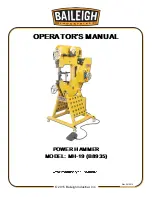
8
8. TROUBLESHOOTING
The following form lists the common operating system with problem and solutions.
Please read the form carefully and follow it.
WARNING: If any of the following symptoms appears during your
operating, stop using the tool immediately, or serious personal injury
could result.
Only a qualified persons or an authorized service center can perform
repairs or replacement of tool.
Disconnect tool from air supply before attempting repair or
adjustment. When replacing O-rings or Cylinder, lubricate with air
tool oil before assembly.
Problem
Possible Causes
Likely Solutions
Decreased
output.
1.
Not enough air
pressure and/ or air
flow.
2.
Obstructed trigger.
3.
Incorrect lubrication
or not enough
lubrication.
4.
Blocked air inlet
screen (if equipped).
5.
Air leaking from loose
housing.
6.
Mechanism
contaminated.
7.
Vane wear or
damage.
1.
Check for loose connections and make sure
air supply is providing enough air flow
(SCFM) at required pressure (PSI) to tool’s
air inlet.
Do not exceed maximum air
pressure.
2.
Clean around trigger to ensure free
movement.
3.
Lubricate using air tool oil and grease
according to directions.
4.
Clean air inlet screen of buildup.
5.
Make sure housing is properly assembled
and tight.
6.
Have qualified technician clean and lubricate
mechanism. Install in-line filter in air supply
as stated in Initial Set Up: Air Supply.
7.
Replace all vanes.
Housing heats
during use.
1.
Incorrect lubrication
or not enough
lubrication.
2.
Worn parts.
1.
Lubricate using air tool oil and grease
according to directions.
2.
Have qualified technician inspect internal
mechanism and replace parts as needed.
Severe air
leakage. (Slight
air leakage is
normal, especially
on older tools.)
1.
Cross-threaded
housing components.
2.
Loose housing.
3.
Damaged valve or
housing.
Dirty, worn or
damaged valve.
1.
Check for incorrect alignment and uneven
gaps. If cross-threaded, disassemble and
replace damaged parts before use.
2.
Tighten housing assembly. If housing cannot
tighten properly, internal parts may be
misaligned.
3.
Replace damaged components.
Clean or replace valve assembly.
Note:
Repairs
should
be
carried
out
by
a
qualified
person




























